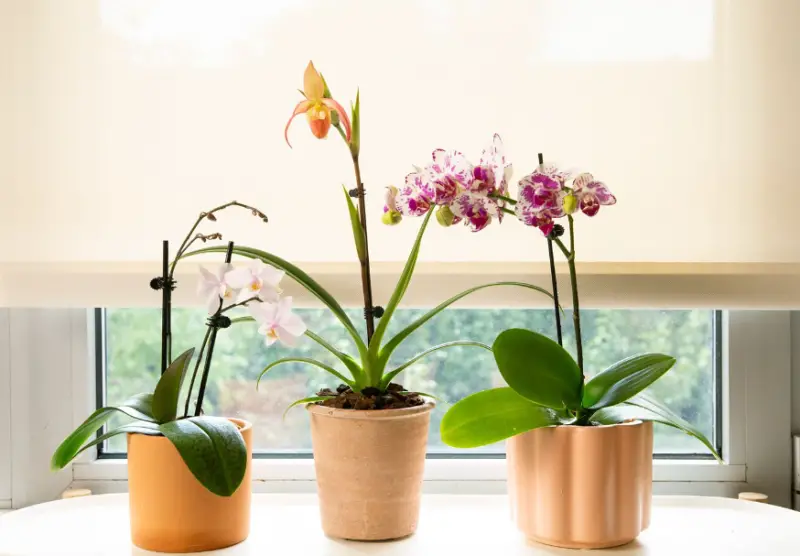Orchids (Orchidaceae) are among the most popular houseplants worldwide, loved for their long-lasting blooms and exotic beauty. While some might think these plants are difficult to care for, once you understand their basic requirements, you’ll find them relatively easy to grow.
This comprehensive guide will walk you through the essentials of orchid care, helping you cultivate healthy plants with spectacular blooms.
Understanding Orchids: Varieties and General Characteristics

There are thousands of orchid species available, but the most common varieties sold in stores are from the Phalaenopsis, Cattleya, Dendrobium, and Cymbidium genera. These orchids share similar physical characteristics, so most of their care requirements are consistent. Here’s a quick rundown of these popular types:
- Phalaenopsis Orchids (Moth Orchids): Known for their broad, rounded flowers with a prominent lip, these orchids are perfect for beginners due to their ease of care.
- Dendrobium Orchids: With narrow leaves and cane-like stems, Dendrobium varieties produce flowers that grow in rows along the stems.
- Cattleya Orchids (Corsage Orchids): Famous for their large, showy blooms often used in corsages, Cattleya orchids are known for their pleasant fragrance and diverse color range.
- Cymbidium Orchids (Boat Orchids): These produce numerous flower spikes, creating a vibrant display, and are an excellent choice for beginners.
Now, let’s dive into the essential aspects of orchid care, from lighting and watering to fertilization and repotting.
Light: The Key to Thriving Orchids
Orchids need plenty of bright, indirect light to thrive. The best spot for an orchid is near a south- or east-facing window, where it can soak up several hours of soft light each day. Be cautious about exposing orchids to direct sunlight, as this can cause leaf burn. If you notice your orchid’s leaves turning yellow or developing black spots, it could be getting too much light. On the other hand, orchids that aren’t getting enough light will produce fewer blooms.
Lighting Tips:
- Position orchids where they receive bright but indirect sunlight.
- Rotate your orchid every few weeks to ensure all sides get even exposure to light.
- If necessary, use a sheer curtain to filter the sunlight.
Watering: Preventing Root Rot
Watering orchids can be tricky because their roots are susceptible to rot. The key is to let the growing medium dry out completely between waterings. Orchids typically need watering once or twice a week, depending on the environment. In warmer months, when the plant is actively growing, it may require more frequent watering. During the colder months, cut back to once a week or less.
How to Water Orchids:
- Water slowly until it runs out of the drainage holes at the bottom of the pot.
- Always use room-temperature water.
- Check the roots before watering. Healthy roots should be plump and white or green. If they’re gray and shriveled, it’s time to water.
Orchids planted in bark or moss will need different watering approaches. Bark dries faster, so it requires more frequent watering than moss.
Ideal Temperature and Humidity
Orchids thrive in temperatures ranging from 50 to 90 degrees Fahrenheit, depending on their variety. Maintaining a humidity level between 40% and 70% is essential to promote healthy growth and blooming.
- Use a humidity tray or a humidifier to increase humidity levels around your orchid.
- Avoid placing your orchid near heating vents or in drafts, as these can cause temperature fluctuations that stress the plant.
Soil: Choosing the Right Growing Medium
Unlike many other houseplants, orchids do not thrive in regular potting soil. They require a well-draining, lightweight growing medium. Most orchid-specific potting mixes are made up of bark, sphagnum moss, perlite, and peat, all of which help ensure that the roots receive adequate air circulation and avoid water retention.
DIY Orchid Potting Mix Recipe:
- 2 parts bark chips
- 1 part sphagnum moss
- 1 part perlite or charcoal
Remember, slightly acidic soil with a pH range between 5.5 and 6.5 is ideal for most orchids.
Fertilizing Orchids
During the growing season (spring and summer), feed your orchid with a balanced fertilizer like 20-20-20 at half strength every two weeks. Reduce fertilization during the dormant period, typically in the winter months. Orchids are sensitive to over-fertilization, so always dilute the fertilizer and avoid using too much.
Fertilizing Tips:
- Use a balanced, water-soluble fertilizer specifically formulated for orchids.
- Fertilize every two weeks during the growing season.
- Skip fertilizing during the winter or dormancy period.
Orchid Care After Flowering
Once the blooms have fallen off, many gardeners wonder how to care for their orchids. Orchids can be encouraged to rebloom with proper care. After flowering, prune the spent flower spike by cutting it just above the node (the small bump on the stem) to encourage new growth. If the spike turns brown, it’s safe to remove it entirely.
Repotting Orchids:
Repotting is crucial to maintaining healthy orchids. Repot every one to two years or when the roots have outgrown the pot. Use a pot with plenty of drainage and airflow, like a clear plastic or terracotta pot with holes on the sides.
Common Pests and Plant Diseases
While orchids are generally hardy, they can occasionally fall victim to pests like aphids, spider mites, and mealybugs. Most pests can be managed by gently brushing them off with a soft cloth or spraying the plant with insecticidal soap or neem oil.
Overwatering can lead to fungal diseases such as root rot and petal blight. To prevent these issues, ensure that your orchid’s growing medium is well-drained and avoid leaving standing water in the pot.
Pruning and Propagating Orchids
Pruning encourages your orchid to produce more flowers. Use sharp, clean scissors or pruning shears to trim back spent flowers. Always sterilize your tools before use to prevent the spread of disease.
If you want to propagate your orchid, the easiest method is by division. Here’s how:
- Moisten the growing medium to make the plant easier to remove.
- Gently separate the roots into two or more sections.
- Pot each section into a new orchid-specific medium.
How to Encourage Orchids to Rebloom
An orchid should bloom at least once a year, and the flowers can last two to four months. If your orchid is not blooming, try reducing the temperature at night by 10 degrees for a few days. This can often stimulate orchid blooms, especially for Phalaenopsis varieties.
Common Orchid Problems and Solutions
- Shriveled and Wrinkled Leaves: Likely caused by insufficient watering. Check the roots and ensure the growing medium isn’t staying dry for too long.
- Yellowing Leaves: Often a sign of overwatering or root rot. Allow the soil to dry out and check the health of the roots.
- Drooping Leaves: This could indicate underwatering or inadequate light. Move the plant to a brighter location and adjust your watering schedule.
- Falling Buds: Dropped buds are a sign that the orchid is under stress. Examine the growing environment for issues such as temperature fluctuations or poor humidity levels.
Conclusion
Orchids are remarkable plants that bring a touch of elegance and beauty to any home. By understanding their specific care requirements—like proper watering, lighting, and humidity—you can keep your orchid healthy and enjoy its stunning blooms for years to come. Whether you’re new to orchid care or a seasoned gardener, following these guidelines will ensure that your orchid thrives and rewards you with its stunning flowers.







I have 2 baby orchids that I took from the mother plant two years ago. I have stopped them from floerong as I thought they were too small. Both now are in bud again. Shoukd I let them flowered or shoukd I remove them again.